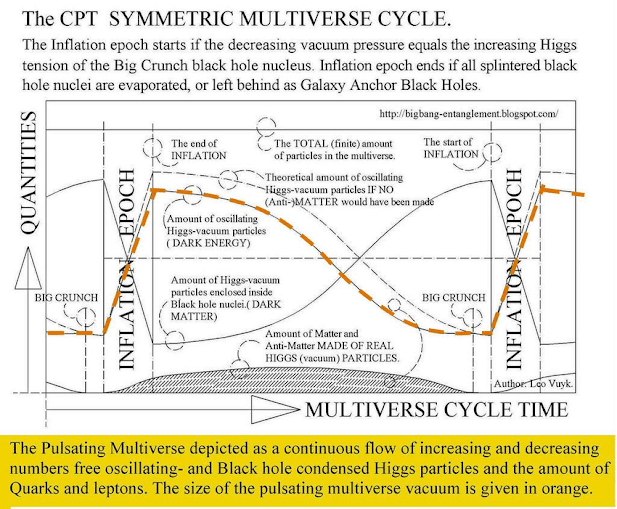Strong comparison between the observed Black Hole distribution of Andromeda and the Dual Herbig Haro GABH system of the Milky Way.
See also: Primordial Black Holes and Dual Herbig Haro Effects for Star-Galaxy Formation.
https://vixra.org/pdf/2101.0158v1.pdf

The Q-FFF Rigid String Theory says: (1) There is only one CONSTRUCTIVE Topological and Resilient TRANSFORMING STRING (Axion/vacuum Dark Energy building block ), forming direct after the Black Hole Splitting Big Bang. so called Travelling TADPOLE Black Hole based Filaments, expanding the Cosmic Lyman Alpha Structure. (2) A Raspberry Entangled 12x Mirror Copy Multiverse is Postulated as base for uncertainty (ER=EPR) and Libet's FREE VETO WILL . SO We live inside an exploded BH
Quantum FFF Rigid String Theory ( FFF= Function Follws string Form)
QUANTUM FFF topological STRING THEORY and the Fermion Propeller.http://vixra.org/author/leo_vuykhttps://www.flickr.com/photos_user.gne?path=&nsid=93308747%40N05&page=&details=1If the big bang was the splitting of a huge Axion/ Higgs particle Dark Matter Black Hole (ELISIUM DM- BH) nucleus into smaller DM-BH nuclei, then no standard Fermion/ Baryon inflation has happened only the DM-BH based Lyman alpha forest equipped with local Herbig Haro star/galaxy creating systems.
All black holes of all sizes (down to ball lightning) seem to be equipped with a Fermion repelling- and plasma producing horizon, which has also a charge splitting effect into a negative (outside) and positive ( inside) zone ( see oriental basin of the moon) .Conclusion, all Bhs are: "Negative Charged Electric Dark Matter Black Holes" with a rigid open string sector with intrinsic 3x hinging curvature.
Friday, May 05, 2023
How Galaxies are created with FIRSTLY one massive short living star between two GABHs in the early universe
Thursday, May 04, 2023
Fermion Propellers are Axion vacuum particle cutters (blue) into photons (Yellow) etc.(Q-FFF String Theory.)
Wednesday, May 03, 2023
The Golden Ratio structure of the Dodecahedron Multiverse (12xpentagons)
An interesting fact is that the dodecahedron pentagon contain each the golden ratio length between two opposite corners.
see: https://bigbang-entanglement.blogspot.com/2023/05/httpsyoutubezjrh74jmtgw-q-fff-theory-by.html
Model Galaxy Formation in the Early Universe. by use of the Renaissance model and much Dark Matter from the Big Bang?
https://arxiv.org/pdf/2304.13755.pdf
In this study, we use results from the Renaissance simulations, which are a suite of high resolution simulations designed to model galaxy formation in the early universe.
We find that the most massive galaxies in Renaissance have stellar masses and star formation rates that are entirely consistent with the observations from the JADES and CEERS surveys.
Tuesday, May 02, 2023
https://youtu.be/zjRh74JMtGw Some start items of The Q-FFF Theory by cartoons.
Monday, May 01, 2023
Before the Big Bang 11: Is the Universe a Time Machine? YES according to Q-FFF Theory: Fixed Cycle Time for each Eon cycle.
A tidal disruption event (TDE) creating a "Tidal formed Disc", which results in a "Transient Flare" leaving the Black Hole.(Q-FFF model)
see: https://iopscience.iop.org/article/10.3847/2041-8213/acc02f/pdf
However, according to the Q-FFF Model of new physics, the black hole could not devour the star (Fermions) due to the new physics "trapped space horizon" of Penrose combined with the Q-FFF postulate that of the black hole, which is repelling all Fermions.
Only the disc formation should be observed as the remnants of the star in combination with the transformation of the plasma disc into both jets leaving the place in opposite direction. into both- or even more GABHs (Galaxy Anchor Black Holes) see also the Andromeda black holes as evidence.
At the same time, those dual jets could be observed also as "Transient fares."
Evidence for the new physics Dual Black Hole distribution of Herbig Haro star systems in the MW and Andromeda Galaxy (Q-FFF Model)
What does the Andromeda and Milky Way distribution look like?: Two main- and multiple secondary arms by multiple Herbig Haro Black Hole mergers.(see: Q_FFF model)
see: Primordial Black Holes and Dual Herbig Haro Effects for Star-Galaxy Formation see: https://vixra.org/pdf/2101.0158v1.pdf
and: https://bigbang-entanglement.blogspot.com/
What does the Milky Way look like?: Two main- and multiple secondary arms by mergers.(see: Q_FFF model)
BY: Y. Xu, et all.
https://arxiv.org/pdf/2304.10690.pdf
In spite of much work, the overall spiral structure morphology of the Milky Way remains somewhat uncertain. In the last two decades, accurate distance measurements have provided us with an opportunity to solve this issue. Using the precise locations of very young objects, for the first time, we propose
that our Galaxy has a multiple-arm morphology that consists of two-arm symmetry (the Perseus and Norma Arms) in the inner parts and that extends to the outer parts, where there are several long,
irregular arms (the Centaurus, Sagittarius, Carina, Outer, and Local Arms).
Figure 4. Density map of the O–B2-type stars and contours of the YOCs, which are over plotted with the MW’s spiral arms (the
black lines) obtained by fitting for the positions of the O–B2-type stars. The red Sun symbol is the position of the Sun. For
the original projected distributions of O–B2 stars and YOCs onto the Galactic disk, please see Figure A1 in Appendix A.

H I emission as a function of LSR radial velocity and Galactic longitude. The colored dots are HMSFR masers with parallax measurements: Norma Arm (orange), Sagittarius Arm (cyan), Carina Arm (green), Local Arm (blue), Perseus Arm (magenta), and Outer Arm (red). The white dots indicate spurs or sources for which the arm assignment is unclear. The H I emission is from the HI4PI survey (HI4PI Collaboration et al. 2016). The subfigure presents a zoomed-in view of the red box, in which the masers are assigned to the Norma Arm (orange crosses) and the Scutum Arm (orange triangles) by R19, respectively, while here they are assigned to the same arm, i.e., the Norma Arm.
Below: The multiple secondary Galaxy Arms suggested to be remnants of former galaxy mergers, by the the Q-FFF Model are only partly visible in the picture 5.see below:
Below see: Large Magellanic Cluster Galaxy Black Hole based irregular GABHs. (probably created by the external GABHs of the Milky Way)
Below: see the small Black Hole network around the Andromeda Galaxy.



















































